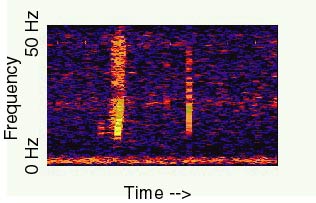Quoted from the Anchorage Daily News: http://www.adn.com/2835/story/864687.html
Huge blob of Arctic goo floats past Slope communities
Something big and strange is floating through the Chukchi Sea between Wainwright and Barrow. Hunters from Wainwright first started noticing the stuff sometime probably early last week. It's thick and dark and "gooey" and is drifting for miles in the cold Arctic waters, according to Gordon Brower with the North Slope Borough's Planning and Community Services Department.
Brower and other borough officials, joined by the U.S. Coast Guard, flew out to Wainwright to investigate. The agencies found "globs" of the stuff floating miles offshore Friday and collected samples for testing.
Later, Brower said, the North Slope team in a borough helicopter spotted a long strand of the stuff and followed it for about 15 miles, shooting video from the air.
The next day the floating substance arrived offshore from Barrow, about 90 miles east of Wainwright, and borough officials went out in boats, collected more samples and sent them off for testing too.
Nobody knows for sure what the gunk is, but Petty Officer 1st Class Terry Hasenauer says the Coast Guard is sure what it is not. "It's certainly biological," Hasenauer said. "It's definitely not an oil product of any kind. It has no characteristics of an oil, or a hazardous substance, for that matter.
"It's definitely, by the smell and the makeup of it, it's some sort of naturally occurring organic or otherwise marine organism."
Something else: No one in Barrow or Wainwright can remember seeing anything like this before, Brower said.
"That's one of the reasons we went out, because in recent history I don't think we've seen anything like this," he said. "Maybe inside lakes or in stagnant water or something, but not (in the ocean) that we could recall ...
"If it was something we'd seen before, we'd be able to say something about it. But we haven't ...which prompted concerns from the local hunters and whaling captains."
The stuff is "gooey" and looks dark against the bright white ice floating in the Arctic Ocean, Brower said.
"It's pitch black when it hits ice and it kind of discolors the ice and hangs off of it," Brower said. He saw some jellyfish tangled up in the stuff, and someone turned in what was left of a dead goose -- just bones and feathers -- to the borough's wildlife department.
"It kind of has an odor; I can't describe it," he said.
Hasenauer said he hasn't heard any reports of waterfowl or marine animals turning up.
Brower said it wouldn't necessarily surprise him if the substance turns out to be some sort of naturally occurring phenomenon, but the borough is waiting until it gets the analysis back from the samples before officials say anything more than they're not sure what it is.
"From the air it looks brownish with some sheen, but when you get close and put it up on the ice and in the bucket, it's kind of blackish stuff ... (and) has hairy strands on it."
Hasenauer said the Coast Guard's samples are being analyzed in Anchorage. Results may be back sometime next week, he said.
The two Coast Guard experts sent up to overfly the area with the borough said they saw nothing that resembled an oil slick, Hasenauer said.
"We brought back one sample of what they believe to be an algae," he said, and a big algae bloom is one possibility.
"It's textbook for us to consider algae because of all the false reports of oil spills we've had in the past. It's one of the things that typically comes up" when a report turns out not to be an oil spill after all.
But, he said, "there's all types of natural phenomena that it could be."
Meanwhile, the brownish-blackish gunk is drifting along the coast to the northeast, Brower said.
"This stuff is moving with the current," he said. "It's now on beyond Barrow and probably going north at this point. And people are still encountering it out here off Barrow."
For the most part, the mystery substance seems to have stayed away from shore.
"We did get some residents saying it was being pushed against the shoreline by ice in some areas," Brower said, "but then we get another east wind and it gets pushed back out there."






















